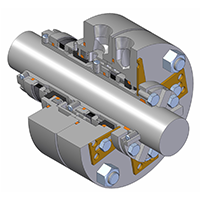Venting of seal pot to prevent contamination
All flush plan 52s (un-pressurized tandem seals) must be continuously vented to flare or safe point to ensure that the seal pot is not contaminated

with the inner seal process fluid release through the outer seal. A laminated warning sign is recommended at each application of this kind.
Un-pressurized dual seals (formerly called ‘tandem’) require an open path to flare or high point safe location to remove all seal fluid vapors (usually flammable and/or toxic) from the seal pot and direct them to a safe location.
A valve closure and/or restriction in the seal pot vent line will prevent removal of the process fluid, contaminate the seal pot safe barrier fluid and expose the plant and its personnel to a flammable or toxic fluid release in the event of an outer (atmospheric side) seal failure.
It is recommended that a local, laminated, warning sign be positioned at the pump. In addition, a short ‘mini information’ presentation by site rotating machinery specialists has been effective in making operators aware of this potential safety hazard.
Buffer fluid circulation
Dual un-pressurized seals (tandem) rely on a buffer fluid at or near atmospheric pressure to lubricate the atmospheric side seal. This buffer fluid is circulated via a pumping ring from the seal to the seal reservoir and back to the seal (in a closed loop).
Plan 52 – dual un-pressurized seal using synthetic buffer fluid to lubricate the atmospheric side seal. A pumping ring in the seal circulates the buffer fluid (pressure less than the seal chamber) to the reservoir.
The reservoir is at atmospheric pressure (less than seal chamber pressure), so the leakage across the process side seal faces migrates into the seal reservoir, and will either increase pressure, level, or both in the reservoir. Since every seal does leak a certain amount, it is essential to have the reservoir vented to a flare or vapor collection system. If the reservoir is allowed to reach the seal chamber pressure, the atmospheric side seal will most likely fall (if it hasn’t already) as it is not typically designed to handle seal chamber pressure.
If this is a concern in the plant, you may want to consider requesting the seal vendor to redesign the atmospheric seal to handle maximum seal chamber pressure. In addition, as the process side seal leaks in this flush plan, the atmospheric side seal will essentially be sealing the pumped fluid, exposing the plant to the release of flammable and/or toxic vapors.
Monitoring of seal leaks can be done by checking the level and pressure of the reservoir, as one or both may increase in the event of excessive leakage. The seal vendor (or support system vendor) may supply high level and/or pressure switches which would alert the operators to a seal leak. It is highly recommended to specify this instrumentation in new projects, as it will cut down on the already high workload of operators (if the alarm sounds then the level or pressure can be personally verified in the field).
Zero or reverse circulation
In addition to checking for excessive leakage (pressure or level increase), temperature in and out of the seal can help verify proper circulation. In a reservoir that is not cooled, there should be a temperature drop of approx. 1 to 2oC (5oF to 19oF) from the seal outlet to the seal inlet. If there is no temperature drop (or if the temperature increases), this indicates zero or possibly reverse circulation.
It has been our experience that Plan 52 flushes may not be vented properly (blocked in) and level may be low or at zero in the reservoir. For these reasons, it is very important for the operators to be trained to understand the necessity of monitoring this system.
Most plants have experienced a release of process fluid from dual un-pressurized (tandem) seal systems when the vent line had been improperly closed off. Lack of awareness of dual un-pressurized (tandem) seal system operational principles has resulted in flammable and toxic fluid releases in many plants.
This best practice has been recommended since the mid-1980s. Since that time, this best practice, when implemented by plant operations, has resulted in optimum dual un-pressurized (tandem) seal safety and reliability (MTBFs > 48 and as high as 80 months).

.png&w=3840&q=75)

.png&w=3840&q=75)



.png&w=3840&q=75)



.png&w=3840&q=75)









